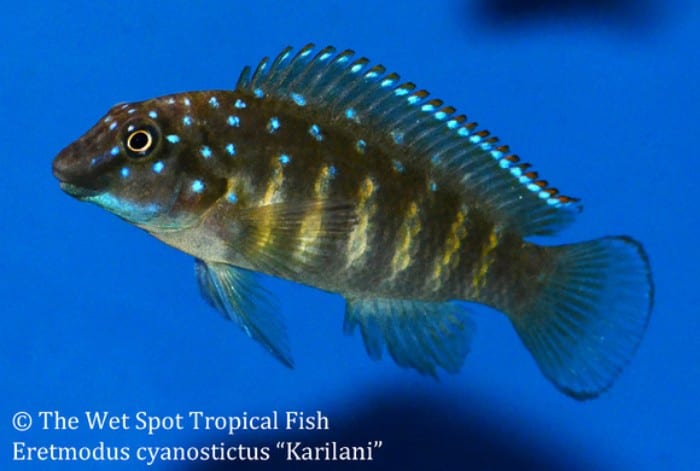Law & Order
Law & Order
As animal lovers and aquarists, we are often drawn to and tend towards adding peaceful, and sure-fire compatible species to our tanks. We all know the dread and sick stomach feeling associated with adding new tank mates that have a tumultuous and sometimes deadly showdowns with the existing alpha species. There’s nothing better, however, than finding beautiful, complex, and nuanced dominant species that fit into the existing structure of your current tank, or even starting a new tank with a well researched and meticulously crafted harmonious hierarchy. African cichlids, specifically Tanganyikan cichlids, are always fascinating centerpieces and tank showstoppers, though they are only fit for the most devoted aquarist caregivers. A few species we find rewarding to work with and observe include Neolamprologus similis, Eretmodus cyanostictus, and Cyathopharynx foae.
Scientific NameNeolamprologus similis
Temperature / pH75 to 81°F / 7.5 to 9.0 pH
Native LocationTanganyika
Preferred DietSmall invertebrates
Along the soft, sandy shoreline of Lake Tanganyika, empty snails shells collect, and along with them, small, fluorescently striped cichlids known as N. similis. Reaching just under 2 inches in length, these cichlids are shell-brooders. Females find suitable shells to guard and form territories to lure males. Once a male has been baited, females lay eggs within the empty snail shell, and as they exit, they create a whirlpool effect that draws the male’s sperm into the shell to fertilize the eggs. The females then stay with their eggs, fanning their fins around the shell until fry are able to venture out without maternal supervision. In captivity, this species requires plentiful open space with fine sandy substrate dotted with snail shell territories for females to defend. Tanks should contain 40 liters for a single pair, though much larger setups should be considered when starting a colony. Colony tanks should have more snail shells than females with 6 inch territories surrounding each shell, and more females than males. Territoriality generally goes hand-in-hand with aggression, and this species is no exception. They can be kept in community tanks with species that inhabit different zones of the tank including small rock-dwellers, or open-water species. Regularly accepting of high quality dried foods, these cichlids require diets with a heavy bias toward live and frozen fare, particularly if they are being bred. Waters should be maintained with temperatures between 75 and 81°F, pH of 7.5 to 9.0, and hardness of 57 to 178 ppm.
Scientific NameEretmodus cyanostictus
Temperature / pH75 to 82°F / 8.0 to 9.0 pH
Native LocationTanganyika
Preferred DietSmall invertebrates
Endemic to the upper few feet of the rocky shores or “surge zones” of Tanganyika are the medium-sized, and pointy-headed E. cyanostictus, otherwise known as “Striped Goby Cichlids”. Using specialised teeth, these cichlids scrape algae off rocks where they brave breaking waves and strong currents. Tank setups should include sandy substrate, and should be dominated with rockwork piled up to create caves and crevices extending to the surface. Algal growth should remain encouraged with strong lighting. Vegetable matter should make up the bulk of their diets, and they thoroughly enjoy blanched spinach and spirulina flake, but they are also known to graciously gulp down occasional small meaty foods like shellfish, brine, and worms. Reaching about 3 inches in length, these fish usually have light-colored bodies with faint striping pocked with bright blue scales, and a red spot on their caudal fins. When displaying, males become yellow with dark striping. Another territorial species, these cichlids are best kept alone or as a single pair, as they are highly aggressive toward conspecifics. Pairs should be allowed to group naturally as juveniles, as you run the risk of female death when they are purchased, and forced to pair as adults. Once these fish pair off, they stay are monogamous for life. As bi-parental mouthbrooders, females carry a couple of fertilized eggs without eating for 2 weeks, and transfer the fry to her mate’s mouth until they are ready to venture out on their own. If adding to a community tank, make sure other species inhabit different tank-niches. Optimal water conditions include temperatures between 75 and 82°F, pH of 8.0 to 9.0, and hardness of 71 to 178 ppm.
Scientific NameCyathopharynx foae
Common NameFeatherfin Cichlid
Temperature / pH75 to 81°F / 8.0 to 9.0 pH
Native LocationTanganyika
Preferred DietHerbivorous
Moving a little deeper into the intermediate zones with sandy bottoms and scattered rocks of Tanganyika, we find C. foae. Also known as “Featherfin Cichlids”, these fish reach up to 8 inches in length, and exhibit beautifully elongated and pointy fins, and a range of light, and dark shiny and colorful bodies depending on their position within the colony’s hierarchy. Boisterous and active, these cichlids require a lot of swimming space relative to their size. Minimum tank size is 365 liters. Tanks should be equipped with shallow sandy-substrate, and scattered rock piles, with a majority of space remaining open. Additionally, biological filtration is essential for happy and healthy specimens. The dominant species of their natural habitats, they should be kept the same in captivity. They do well alongside peaceful species that are hard-water tolerant, who look after themselves well. Candidates include Cyprichromis sp. and Altolamprologus sp. Herbivorous by nature, meaty or high-protein foods should be avoided with the base of their diets consisting of vegetable matter like blanched spinach, spirulina, and nori; they will accept a variety of high quality vegetable flake or pellets. Water conditions should be maintained with temperatures between 75 and 81°F, pH between 8.0 and 9.0, and hardness of 57 to 178 ppm.
The most satisfying things in life are hard-won. We like to work to earn our fishes favor, and to observe their remarkable social dynamics, expression of dominance coloration, and courtship rituals. Ready to take the plunge, or expand your cichlid repertoire? Give us a call at The Wet Spot, and we’ll “hook” you up!
**Note: we only net – no literal hooks!**


